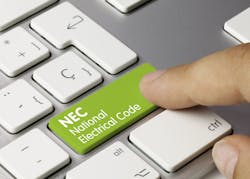Article 460 of the NEC provides the requirements for installing capacitors on electrical circuits [460.1]. It does not address surge capacitors or capacitors included as components of other apparatus (e.g., electronics circuits).
Power factor correction is the main reason capacitors are installed in electrical circuits. For example, motor loads are inductive. When you do the math and plot the values on a chart, you see the inductive loads shift the power vector to one side of the vertical axis. Add capacitance, and you start shifting it back in the other direction. Add exactly the right amount of capacitance, and you get that vector vertical (which means 100% power factor).
Unfortunately, the usual motivation for power factor correction is to avoid the utility’s power factor penalty, so the capacitors are installed at the service entrance. The problem is you have unity power factor only on the utility side of those capacitors, and you still have low power factor all the way out to the load. So, you’re still wasting money and running motors hotter than they need to run. It’s better to correct power factor at the source. With motors, installing a power factor corrected variable speed drive is often the best solution. One reason it’s best is those capacitors are included as components of the drive, which means you don’t have to worry about Art. 460 violations (there are other reasons, too).
So, what kinds of violations might you need to be concerned about if you install capacitors that are covered by Art. 460?
The first thing you have to remember is they store energy. This isn’t so good for first responders, since capacitor banks must have a disconnecting means in each ungrounded conductor, and it must meet the three requirements of 460.8(C).
If the capacitors contain more than 3 gal of flammable liquid, they must be enclosed in vaults or outdoor fenced enclosures [460.3(A)]. Where practical, make them inaccessible to persons who are unauthorized or unqualified; this is often done through a combination of engineering and administrative controls. Where not practical, or as another layer, enclose, locate, and/or guard them to prevent accidental contact by people or materials with the capacitors’ energized parts, terminals, or buses [460.3(B)].
Capacitors of 1,000V nominal or less must have a means of discharging their stored energy to less than 50V within 1 min. of disconnecting the capacitor from its supply [460.6]. A manual means of switching or connecting the discharge circuit is strictly forbidden.
The ampacity of the capacitor circuit conductors must be at least 135% of the rated current of the capacitor [460.8(A)]. Provide an overcurrent protection device (OCPD) in each ungrounded conductor. The rating or setting of the OCPD must be as low as practicable [460.8(B)]. If you install a capacitor on the load side of the motor overload device, the rating or setting of that device must be based on the improved power factor of the motor circuit [460.9].
Bond capacitor cases to the equipment grounding (bonding) conductor [460.10]. This keeps those cases at the same potential as other metallic objects, thus eliminating dangerous differences of potential. Although the NEC uses the term “grounding” in 460.10, do not ground instead of bond because grounding does not eliminate dangerous difference of potential.
Capacitors over 1,000V nominal are covered in Part III. You won’t encounter these for power factor correction in 480V premises wiring for power distribution. But they may be used to supply a higher voltage for specific operations or specific equipment. As with their lower voltage counterparts, they require a means of discharge [460.28], and their cases must be bonded [460.27]. But their requirements differ in important ways. For example, over 1,000V you must provide a means of isolation [460.24(B)]. Its job is to isolate each capacitor (or bank of capacitors) from all sources of voltage. Sounds like a disconnecting means, right? Well, not quite. The isolation means must provide a visible gap in the electrical circuit, and it must be adequate for the operating voltage.
About the Author

Mark Lamendola
Mark is an expert in maintenance management, having racked up an impressive track record during his time working in the field. He also has extensive knowledge of, and practical expertise with, the National Electrical Code (NEC). Through his consulting business, he provides articles and training materials on electrical topics, specializing in making difficult subjects easy to understand and focusing on the practical aspects of electrical work.
Prior to starting his own business, Mark served as the Technical Editor on EC&M for six years, worked three years in nuclear maintenance, six years as a contract project engineer/project manager, three years as a systems engineer, and three years in plant maintenance management.
Mark earned an AAS degree from Rock Valley College, a BSEET from Columbia Pacific University, and an MBA from Lake Erie College. He’s also completed several related certifications over the years and even was formerly licensed as a Master Electrician. He is a Senior Member of the IEEE and past Chairman of the Kansas City Chapters of both the IEEE and the IEEE Computer Society. Mark also served as the program director for, a board member of, and webmaster of, the Midwest Chapter of the 7x24 Exchange. He has also held memberships with the following organizations: NETA, NFPA, International Association of Webmasters, and Institute of Certified Professional Managers.
